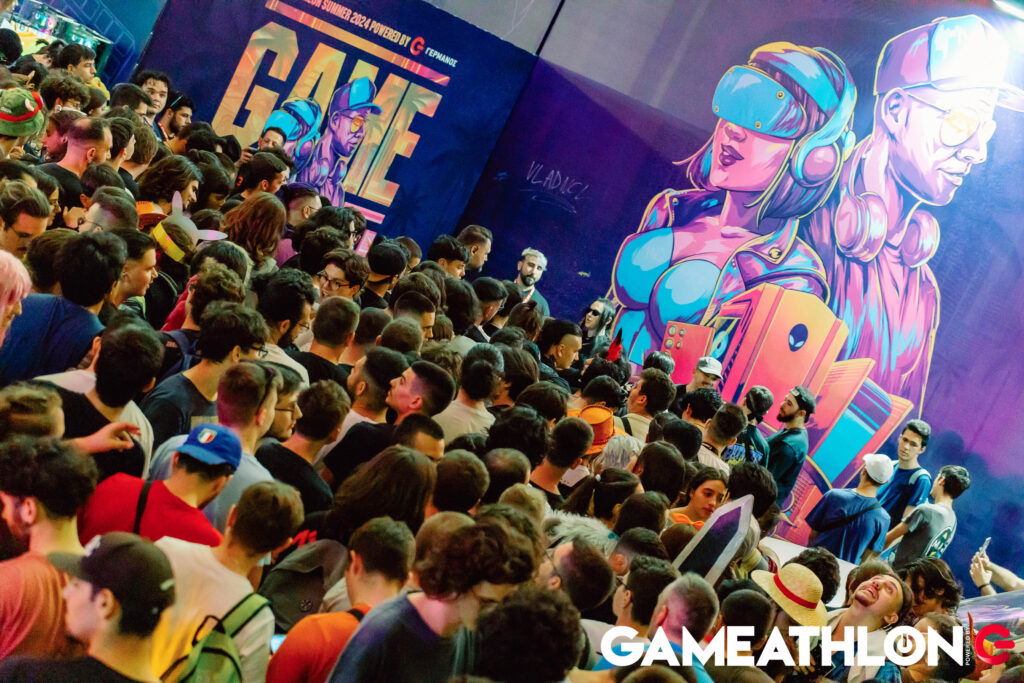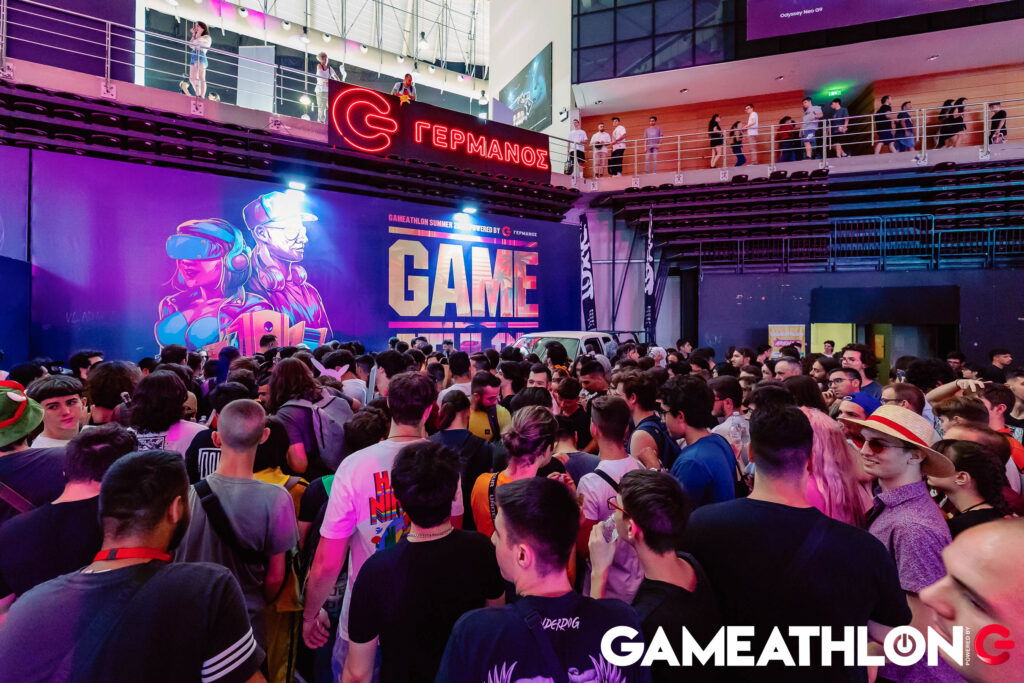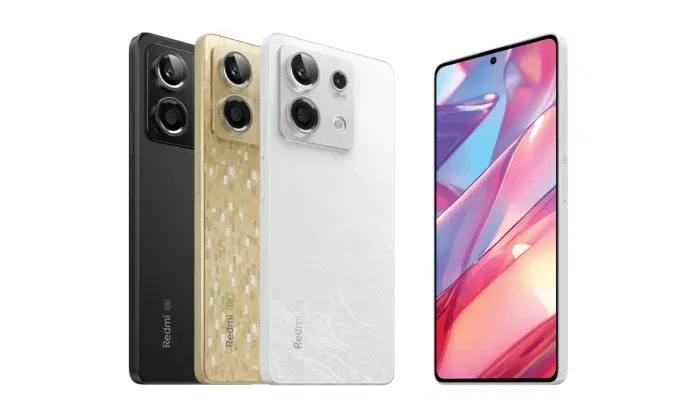Το GAMEATHLON, η μεγαλύτερη και παλαιότερη έκθεση τεχνολογίας και video games στην Ελλάδα, επιστρέφει δυναμικά στην 12ή εξελιξη, 22-23-24 Νοεμβριου 2024, στα 14 στρεμματα του Tae Kwon Do. Όπως πάντα με μέγα Χορηγό τον ΓΕΡΜΑΝΟ, ηγέτη στην τεχνολογία, καθως και τα μεγαλυτερα brands του χώρου να δίνουν το παρών.
Gamers και λάτρεις της τεχνολογίας αλλα και της pop κουλτουρας ετοιμάζονται να κατακλυσουν την ολυμπιακή αρένα του Παλαιού Φαλήρου από όλες τις γωνίες της Ελλαδας για να διαγωνιστούν στα μεγαλύτερα πρωταθλήματα ηλεκτρονικού αθλητισμού, να δουν τις τελευταίες εξελίξεις στην τεχνολογια ή το gaming καθως και να λάβουν μέρος στις αμετρητες δρασεις που προφερονται στα περιπτερα των χορηγών αλλα και των συντελεστων μας!
Ετοιμαστείτε να τηλεμεταφερθείτε σε εναν αλλο κοσμο, γεμάτο φωτα, ηχο και εικόνα σε μια απαράμιλλη οπτικοακουστική υπερπαραγωγή ευρωπαικων προδιαγραφών:
- Τα μεγαλύτερα Esports Tournaments: Δοκιμάστε τις ικανότητές σας σε πάνω από 37 διαφορετικά Τουρνουά, όπως League of Legends, Tekken, EA FC, Fortnite και Valorant, διεκδικώντας χιλιάδες ευρώ σε έπαθλα σε δωρα!
- ΓΕΡΜΑΝΟΣ gaming lounge: 80 τετραγωνικα μέτρα γεμάτα τεχνολογία, κονσόλες και διαγωνισμους με υπέροχα δώρα.
- Για πρώτη φορά στην Ελλάδα μια αποκλειστική ζώνη για female Gaming με καλεσμενη την κορυφαια ευρωπαϊκή ομάδα, SK Avarosa, με δράσεις από την COSMOTE! Η COSMOTE, στο πλαίσιο της πρωτοβουλίας #EQUALESPORTS της Telekom, στηρίζει τις γυναίκες gamers και τους δίνει τη δυνατότητα να αναδείξουν το ταλέντο τους.
- Παρουσιάσεις Παιχνιδιών/Προιοντων: Ανακαλύψτε τα πιο hot νέα παιχνίδια και συσκευές gaming της αγοράς με highlight την παρουσια της CD MEDIA του μεγαλυτερου διανομέα στην νοτιοανατολικη ευρωπη φέρνοντάς την μαγεια της NINTENDO, Ubisoft και 2Κ .
- Cosplay Show: Ο νο1 Διαγωνισμος στην Ελλάδα με χιλιάδες θεατές, τα καλυτερα επαθλα και την οπτική extravaganza του 360 stage για θεατές αλλα και διαγωνιζόμενους. Είναι μια πραγματικά μοναδική εμπειρία και το εκρηκτικό φιναλε του διημερου υπό την χορηγία της Old Spice για παραμένουμε φρέσκοι σε όλο το event!
- Εμπειρίες VR & AR: Ζήσε συναρπαστικές περιπέτειες σε εικονική και επαυξημένη πραγματικότητα, αγγίξτε το μέλλον του gaming μέσα από ξεχωριστές τεχνολογίες !

- Meet & Greet με Influencers: Συναντήστε από κοντά πανω απο 400 αγαπημένους streamers, youtubers ή pro gamers και μοιραστείτε μαζί τους απιθανες στιγμές!
- SAMSUNG Experience: Στα 100τμ απόλυτης τεχνολογίας το περίπτερο της SAMSUNG σας προσκαλεί να ζήσετε από κοντά μια μοναδική Gaming εμπειρία με AI (artificial intelligence) τεχνολογίες στις καλύτερες τηλεοράσεις και κινητά της Samsung. Οι Snapdragon 8 Gen3 & NQ8 AI Gen3 επεξεργαστές των S24 Ultra και Neo QLED 8K αντίστοιχα, θα απογειώσουν την οπτικοακουστική σου εμπειρία. Θα δείτε επίσης το μέλλον στα Samsung Gaming Monitor με τα κορυφαία Odyssey OLED με specs που αγγίζουν τα 360Hz & 0,03ms!
- HEGA 2024: Τα βραβεια ελληνικών videogames σε συνεργασία με τον Σύλλογο Δημιουργών Ψηφιακών Παιχνιδιών Ελλάδος, επιστρέφει βραβευοντας τις μεγαλύτερες επιτυχίες της χρονιάς που πέρασε παρουσία στελεχών και επισήμων εθνικών οργανισμων.
- KFC Gaming Area: Είτε με το δικό σου PC ή κονσόλα, είτε θες απλά να λιώσεις, είτε να λάβεις μέρος στα τουρνουά που θα γινουν εκεί, η gaming arena των KFC είναι το κατάλληλο σημείο για να βουτήξετε σε ατελείωτες ώρες gaming και τραγανού κοτόπουλου!
- Red Bull Zone: Νικήστε τους αντιπάλους σε συναρπαστικούς διαγωνισμούς εξομοίωσης ταχύτητας με τα φτερά του Red Bull!
- Anda Seat Comfort Zone: Απολαύστε την ποιότητα και την εργονομία των Anda Seat gaming chairs, για κορυφαία άνεση σε εργασία και gaming!
- Και πολλά άλλα: Workshops, Shopping , διαγωνισμοί, δώρα, εκθέσεις, μουσική και φαγητό!


Το GAMEATHLON BLACK FRIDAY EDITION 2024 powered by ΓΕΡΜΑΝΟΣ είναι μια εκδήλωση για όλους, από όλη την επικράτεια της Ελλάδας. Κάθε έξι μήνες χιλιαδες κοσμου απο καθε ηλικία και φάσμα της κοινωνιας, μαζευονται με κοινο σκοπο την απολυτη ψηφιακή διασκεδαση σε όλες τις μορφές, γιατι ολοι είμαστε… gamers!
Για περισσότερες πληροφορίες:
○ Facebook: https://www.facebook.com/gameathloneu/
○ Instagram: https://www.instagram.com/gameathlon/
#GAMEATHLON #BLACKFRIDAY #MEGAEVENT
VIA: PSAddict.gr
Greek Live Channels Όλα τα Ελληνικά κανάλια:
Βρίσκεστε μακριά από το σπίτι ή δεν έχετε πρόσβαση σε τηλεόραση;
Το IPTV σας επιτρέπει να παρακολουθείτε όλα τα Ελληνικά κανάλια και άλλο περιεχόμενο από οποιαδήποτε συσκευή συνδεδεμένη στο διαδίκτυο.
Αν θες πρόσβαση σε όλα τα Ελληνικά κανάλια
Πατήστε Εδώ
Ακολουθήστε το TechFreak.GR στο Google News για να μάθετε πρώτοι όλες τις ειδήσεις τεχνολογίας.


![Xiaomi Robot Vacuum S10T: Απίστευτη Ισχύς 8000pa [KUPÓNY]](https://cybervista.b-cdn.net/wp-content/uploads/2024/11/xiaomi-vacuum-s10t-unboxing-xiaomiplanet-cover-696x365.jpg?v=1732008187)
